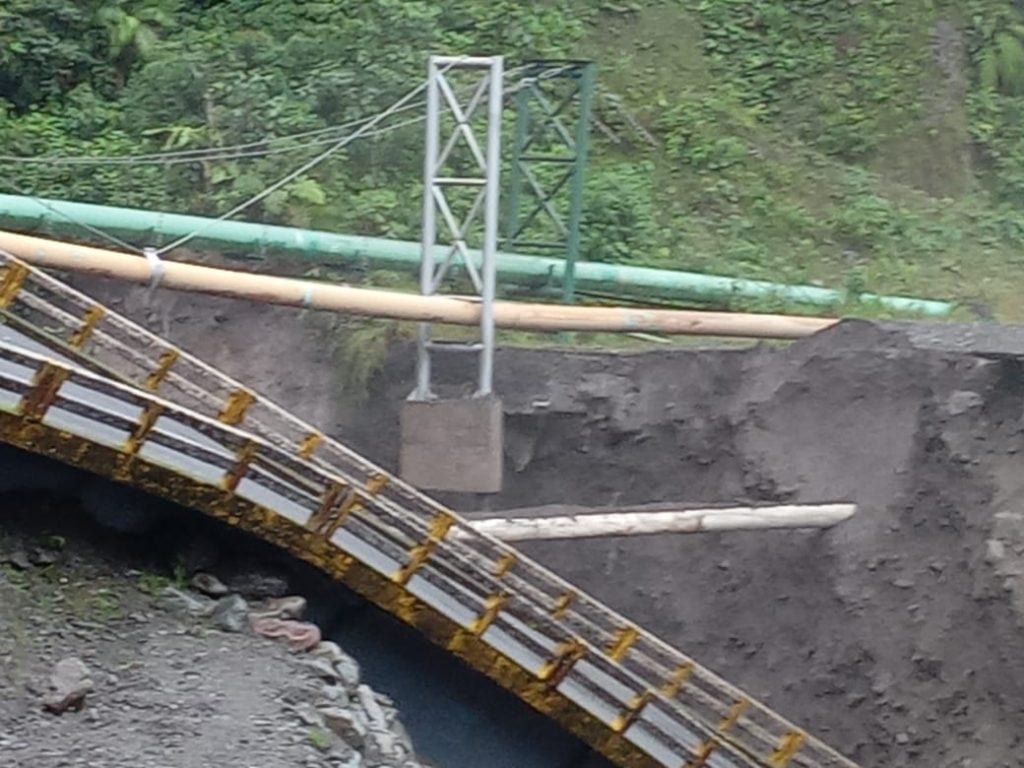The oil industry in Ecuador is facing a new turn, which led to the declaration of force majeure on exports and production for a period of nearly two weeks, after a landslide caused the closure of a number of pipelines.
Petro Ecuador and the independent pipeline operator OCP decided to suspend operations and transportation through those pipelines, in a precautionary step following the collapse of a bridge in Napo province, according to a statement by the Ministry of Energy and Minerals reported by BN Americas.
The declaration of force majeure allows avoiding the repercussions of stopping lines and sales that oil buyers may demand from Petro Ecuador, according to what was followed by the specialized energy platform.
Collapse and stop facilities
A landslide hit a bridge parallel to two oil pipelines in Ecuador, which intersect the Marker River, last Wednesday, February 22 (2023).
The “SOT” pipeline – which has a length of 497 km – has a capacity of 360,000 barrels per day, and supplies the country’s refinery and an offshore terminal, and the “Shushovindi-Quito” pipeline has also stopped, according to Reuters.
The state-owned Petro Ecuador Company formed task forces to assess the repercussions of the bridge collapse and the impact of the transport infrastructure, before asking the Ministry of Energy and Minerals to approve the force majeure declaration.
The company stated that suspending the transmission of flows through pipelines may protect the country from any expected environmental damage during the post-collapse phase.
Preliminary forecasts indicated that heavy rains caused the collapse of the bridge parallel to the two pipelines. This prompted the OCP line operator to stop pumping flows.
oil production
Force majeure and pipeline suspension may hamper Ecuador’s oil production plans; The South American country has previously announced that it aims to produce 521,000 barrels per day during the current year (2023).
Despite the ambitious production goals; Oil production in Ecuador recorded 489,560 barrels per day in January (2023), and it decreased to 481,565 barrels per day, during the period from early February to 21 of the same month.
Transport pipelines usually contribute to increasing the country’s productive capacity; The SOT pipeline transported an estimated 319,40 barrels per day during the past year (2022), up 6% from the previous year (2021), according to energy platform Argus Media.
The line was previously closed and operations stopped in December (2021), following the collapse of nearby sites in Nabu County – as well -.
the majeure force
The repercussions of the disruption to Ecuador’s oil transportation under the force majeure declaration include the suspension of exports for nearly two weeks, and the closure of a number of producing oil wells, according to the Ecuador Times.
And allow the approval of the Ecuadorean Minister of Energy, “Fernando Santos” to the request of the company “PetroEcuador” to declare a state of force majeure to avoid the fines of supply contracts.
On the other hand, this step may revive the country’s refining capabilities. The interruption of transmission lines pushes to enhance the delivery of oil stocks in the “Palau” region to refineries.
Santos said he had given the green light to Petro Ecuador to import quantities of fuel to ensure domestic demand was met, despite the availability of 1.8 million barrels of oil in storage facilities that could meet demand.
facilities at risk
The declaration of force majeure on the oil sector in Ecuador recently included the cessation of 3 facilities starting from February 22, after the landslide caused severe damage to the Marker River Bridge.
The 3 facilities are: the “SOT” pipeline, the “Shushufendi-Kito” line, in addition to a third line for transporting heavy crude oil with a capacity of 151 thousand barrels per day belonging to the “OCP” consortium.
Parts of those facilities were bent and twisted, and the protection teams were able to unload the “OCB” line of fuel supplies, while those attempts were not successful with the flows of the “SOT” line so far.
While the Chushufendi Quito pipeline – with a capacity to transport 5,151 barrels of gasoline, diesel and locally consumed gas – was the hardest hit.
The 3 pipelines have been facing dangers since 2020, as a result of landslides, which cast negative shadows on the oil sector in Ecuador and led to the cessation of export operations.
The facilities were stopped for the first time on April 8, 2020, and then during the period from December 8 to December 30, 2021, in addition to the current stop.
Also read..

Leave a Reply